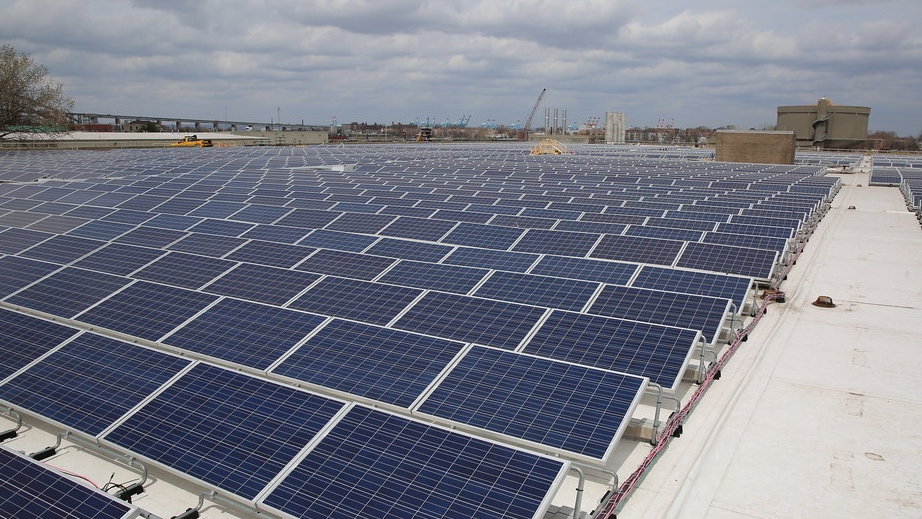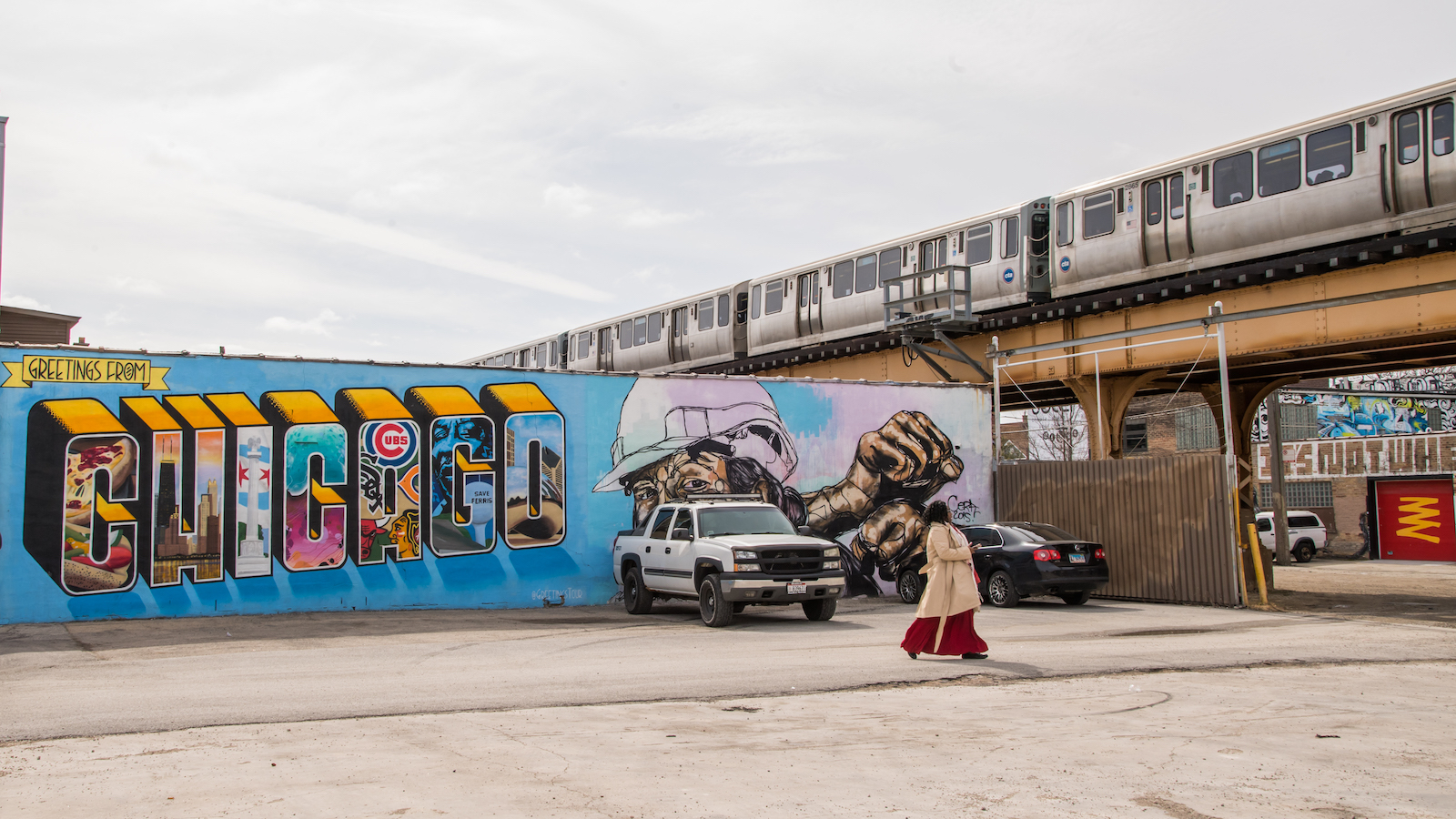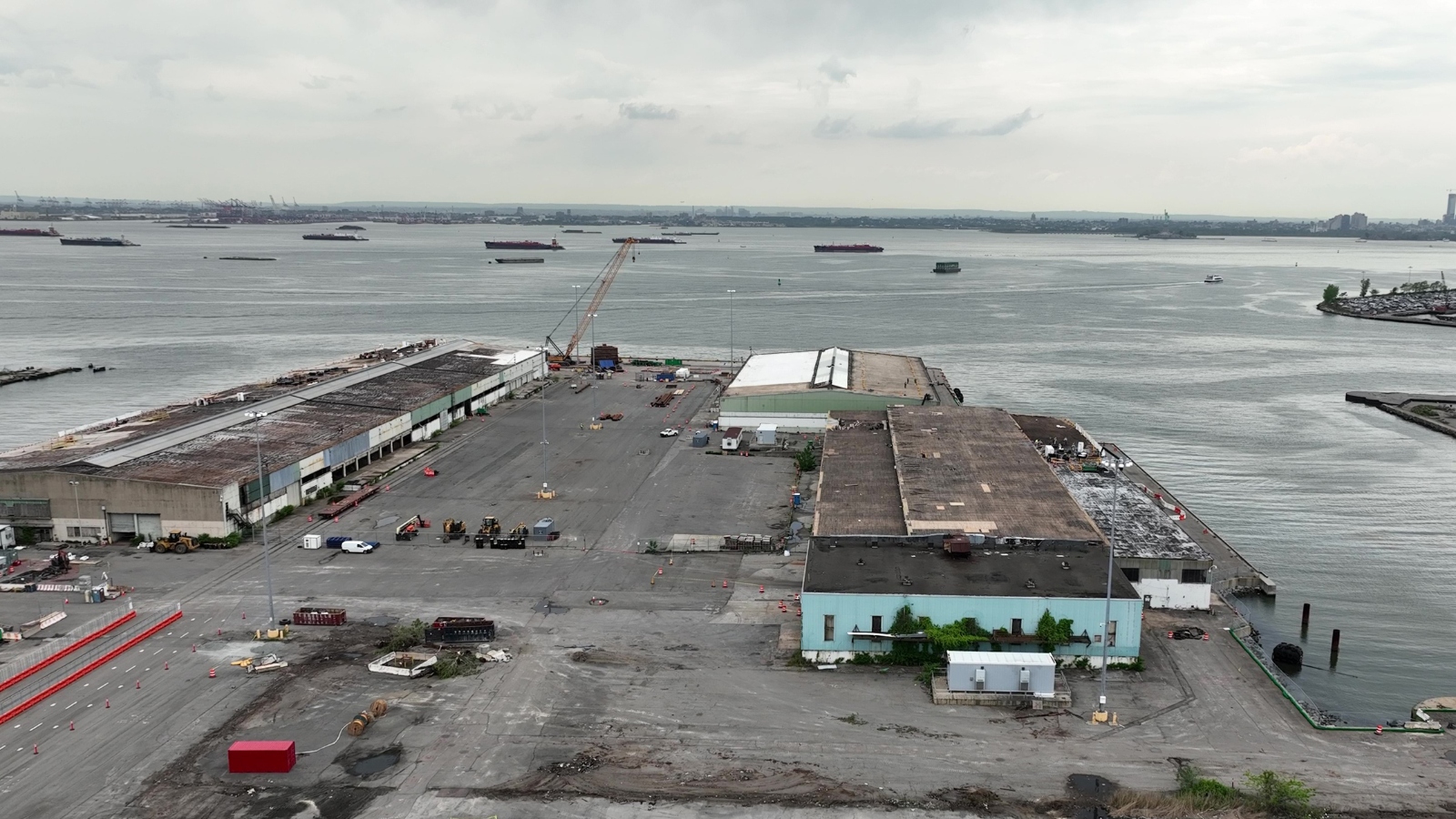
On a pair of aging piers jutting into New York Harbor, contractors in hard hats and neon yellow safety vests have begun work on one of the region’s most anticipated industrial projects. Within a few years, this expanse of broken blacktop should be replaced by a smooth surface and covered with neat stacks of giant wind turbine blades and towers ready for assembly.
The site will be home to one of the nation’s first ports dedicated to supporting the growing offshore wind industry. It is the culmination of years of work by an unlikely alliance including community advocates, unions, oil companies, and politicians, which hope the operations can help New York meet its climate goals while creating thousands of high-quality jobs and helping improve conditions in Sunset Park, a polluted neighborhood that is 40 percent Hispanic.
With construction finally underway, it seems that some of those hopes are coming true. Last month, Equinor, the Norwegian oil company that is building the port, signed an agreement with New York labor unions covering wages and conditions for what should be more than 1,000 construction jobs.
The Biden administration has been promoting offshore wind development as a key piece of its climate agenda, with a goal of reaching 30,000 megawatts of capacity by 2030, enough to power more than 10 million homes, according to the White House. New York has positioned itself as a leader, setting its own goal of 9,000 megawatts installed by 2035.
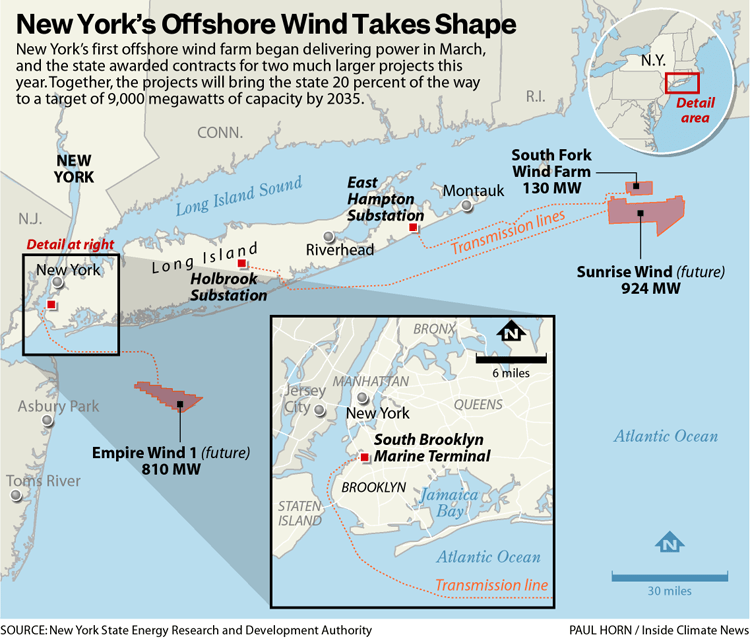
Officials at the state and federal levels have seized on the industry as a chance to create a new industrial supply chain and thousands of blue-collar, high-paying jobs. In 2021, New York lawmakers required all large renewable energy projects to pay workers prevailing wages and to meet other labor standards. The Biden administration has included similar requirements in some leases for offshore wind in federal waters to encourage developers to hire union labor.
While the last year has brought a series of setbacks to the offshore wind industry, including the cancellation of several projects off New Jersey and New York that faced rising interest rates and supply chain problems, many of the pieces for offshore wind are falling into place. New York’s first utility-scale project began delivering power in March, while two much larger efforts, including one that Equinor will build out of the new port, are moving toward construction. Together, they will bring the state about 20 percent of the way to its 2035 target.
Community leaders in Sunset Park have cheered these wins, but they say it remains unclear how many of these jobs will actually go to residents of the neighborhood, a working-class community where the port is being built. It was the promise of green industrial jobs that brought community activists together with Equinor and political leaders to rally behind a proposal to redevelop the South Brooklyn Marine Terminal.
Now, as work proceeds, the effort helps highlight how difficult and complicated it can be to pair the transition to green energy and job creation with environmental justice concerns, even when all the players pledge support to that goal.
“It’s a thing that often falls off the table,” said Alexa Avilés, who represents Sunset Park on the New York City Council, about the priorities of communities. She worries that efforts to hire locally might bring workers from other parts of New York City or state, “and then we, the local community, never see any direct benefit. We see all the workers coming in and our folks are unemployed.”
‘We want good pay’
On a gray day in March, about 100 union members and government and corporate officials gathered in a glass-walled meeting room overlooking Queens, in a training center run by the International Brotherhood of Electrical Workers. They were there to celebrate the signing of a project labor agreement between Equinor and local unions, versions of which will be required for similar projects up and down the East Coast.
Senator Charles Schumer, the New York Democrat and majority leader, said it was the culmination of years of work, including the hard-fought passage of an infrastructure law and then the Inflation Reduction Act, which ushered in renewable energy tax credits and financing, much of which is pegged to labor standards.
“New York can be the center of offshore wind in the whole country,” Schumer said. “But I said, ‘I’m not doing this unless labor is included and labor is protected.’ We don’t want to see low-wage jobs with no pensions and no health benefits build this stuff. We want good pay. We want good benefits. We want good health care.”
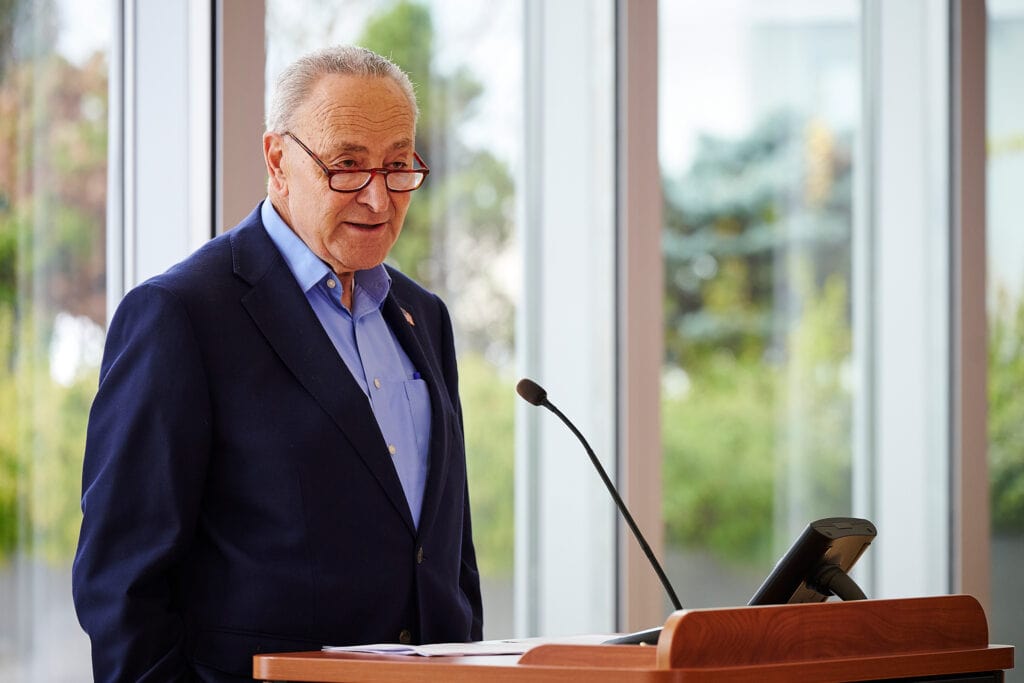
The transition away from fossil fuels has brought uncertainty to workers in the energy sector. While the number of jobs in the renewable energy industry has been growing, wind and solar generation have lower unionization rates than coal or natural gas, according to the U.S. Department of Energy. Many people have expressed fears that building electric vehicles will require fewer workers than conventional cars, though there may be little data to support that concern.
For labor leaders and many Democrats, offshore wind has been the counter to these fears. A report by the National Renewable Energy Laboratory estimated that a domestic offshore wind industry in line with the Biden administration’s goals could create as many as 49,000 jobs, and New York and other states have been enacting legislation aimed at encouraging the industry to create as many jobs as possible with high labor standards.
More than 400 miles up the coast, Kimberly Tobias successfully lobbied the state legislature in Maine, where she is completing an apprenticeship with the International Brotherhood of Electrical Workers, to require some of the same standards that New York had adopted in 2021. Tobias grew up about 15 miles from the town of Searsport, which Governor Janet Mills recently selected as the site for Maine’s first offshore wind port. Tobias said the development will provide steady work that has been elusive in the renewable energy sector.
“This is my 21st solar field in three years,” Tobias said, speaking via Zoom from a solar development where she was taking a break from installing panels. “The promise of being able to go to the same place for a project that’s projected to be five years, that’s a huge deal.”
Tobias said she hopes the offshore wind industry can help replace the jobs that Maine has lost from the decline of other industries like paper mills.
In the opposite direction, workers have already leveled the ground for a large wind port in Salem County, New Jersey, that will have room not only for staging assembly of turbines but also for manufacturing their parts.
At the signing in Queens, Schumer said, “We always thought there ought to be three legs to the stool: environment, labor, and helping poor communities that didn’t have much of a chance. And South Brooklyn Marine Terminal really met all three of the legs of the stool.”
But a more nuanced picture emerged the following week at a community board meeting in Sunset Park. There, several dozen people packed into a less glamorous room on the ground floor of a public library to hear a presentation by Equinor and its contractors about the project. Placards lining the walls advertised the benefits the project will provide the neighborhood and the state, and speakers pledged to create more than 1,000 jobs and to keep open communications with the community.
They would minimize truck traffic, they said, by coordinating deliveries and bringing in supplies by rail or barge when possible. A major elevated highway bisects Sunset Park, and two polluting “peaker” power plants line the waterfront, firing up on hot summer days when power demand soars.
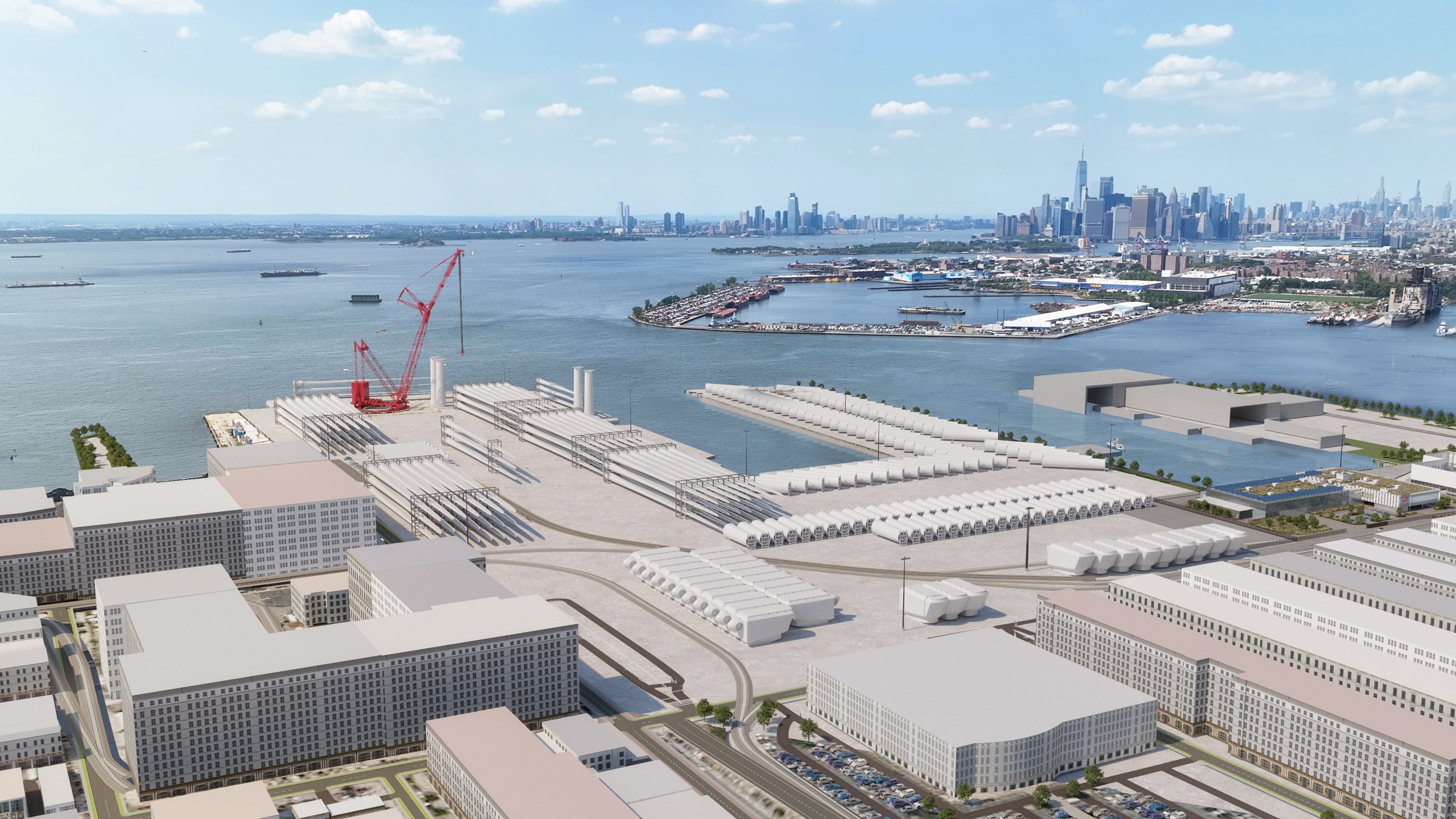
Equinor
They spoke about a learning center the company would build and about $5 million in grants that Equinor had given to city organizations, including funding workforce training and programming at a rooftop vegetable farm in Sunset Park.
But when it came time for questions, several community leaders echoed different versions of the same query: How many jobs will go to local residents? A confounding answer emerged.
A spokesperson for Skanska, the construction firm that was hired to build the port, said they were encouraging neighborhood residents to apply but that they need to hire through the unions. He said some small portion of jobs could be nonunion, particularly those that would come as part of a commitment to hire businesses owned by minorities and women.
The union requirements, then, might actually get in the way of hiring residents of Sunset Park.
A couple of days before the community meeting, Elizabeth Yeampierre voiced these same concerns in an interview in her Sunset Park office, where she is executive director of UPROSE, an environmental justice advocacy group that supported bringing the wind port to the neighborhood.
“There’s entire categories of people that we’re concerned about,” Yeampierre said. “We’re concerned about people who don’t speak English, people who are undocumented, people who are coming out of the prison system, mothers, single mothers with children — how are we going to make sure that those people are brought in?”
Yeampierre remains supportive and excited about the wind port and what it can bring to the community. For years, UPROSE has fought to bring green industry to Sunset Park to help clean up the community and provide working class jobs that pay better than retail and other sectors.
UPROSE received one of the community grants from Equinor to fund a “just transition training center” that will help connect people in the neighborhood with training programs in different green industries. But Yeampierre said the city’s building trade unions also need to make an effort to expand their ranks.
“The truth is that if you want to hire people locally, and you want to make sure that historically marginalized communities get first dibs,” Yeampierre said, “then you need to create avenues for them to be able to go into these industries, and into this work. I don’t see that happening.”
Vincent Alvarez, president of the New York City Central Labor Council, a coalition of 300 unions, said his members were working with city agencies and officials to encourage local hiring in offshore wind. Many of those hires, he said, could be for administrative positions, security, and warehouse jobs at the Brooklyn port, positions that will be less specialized than in construction.
An Equinor spokesperson said the project labor agreement signed with the unions includes a “local hire requirement that gives priority to union members who live in Sunset Park,” but did not say how many people that might apply to. Representatives of Equinor and Skanska have said that in addition to direct jobs, additional money will flow to the neighborhood in the form of indirect jobs, feeding the new workers, for example, or providing other supplies.
Avilés, the city councilmember, said she and other community leaders continue to support the unions.
“We will always fight for a unionized workforce, because we know how important union work is for strong working class communities. But we also know we have people that are going to be outside of that, who also need dignified work.”
Now, Avilés said, she and other community leaders will continue to press Equinor, the unions and city agencies to make sure as many jobs go to Sunset Park as possible.
“It’s annoying that the work is here upon us, and we’re still kind of asking the same questions” about what benefits will flow to the community, “but I don’t think that closes the opportunity.”
Work on the port is expected to last three years. And if the offshore wind industry expands as state leaders hope, there will be years of construction of new projects beyond that.
